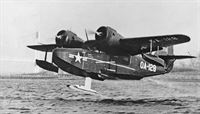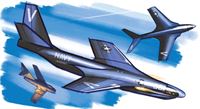Фотографии
-
The futuristic Betta No 1 was a study for a supersonic waterborne attack aircraft, and incorporated a small 60°-swept delta wing, twin retractable hydro-skis and three fuselage-mounted General Electric J53 engines without afterburners fed by a crescent-shaped air intake mounted on the upper surface of the fuselage, plus a small fin.
Самолёты на фотографии: Convair F2Y Sea Dart - США - 1953
-
Resembling an exotic deep-sea fish, the Betta No 2 returned to the blended wing/hull configuration developed during the Skate studies, dispensing with the Betta No 1’s hydro-skis. Both Nos 1 and 2 were extensively windtunnel-tested during the first half of 1950.
Самолёты на фотографии: Convair F2Y Sea Dart - США - 1953
-
Convair’s water babies Skate to Sea Dart, 1946-52
Самолёты на фотографии: Convair F2Y Sea Dart - США - 1953Convair Skate / Cudda - США - 1949
-
Extensive hydro-ski tests were undertaken using various types, including this Grumman JRF-5 fitted with a single hydro-ski on a fixed strut. During alighting a hydro-ski presents only a small area for impact; as the aircraft decelerates the ski takes more of the load until it submerges and the aircraft settles gently on to the surface.
Самолёты на фотографии: Grumman G-21/JRF/OA-9/OA-13 Goose - США - 1937
-
The starting point for Convair’s waterborne fighter project was, perhaps surprisingly, the company’s four-engined XB-46 bomber, which made its first flight on April 2, 1947, although work on what would become the Skate had started back in late 1945.
Самолёты на фотографии: Convair B-46 - США - 1947
-
A contemporary Convair illustration showing how the XB-46 design provided the basis for the first iteration of the Skate, with the removal of the wing-mounted pods containing the engines, and the latter’s relocation within a revised blended hull.
Самолёты на фотографии: Convair B-46 - США - 1947Convair Skate / Cudda - США - 1949
-
A Convair technician prepares a scale model of one of the later Skate iterations, possibly the Skate 6 or 7, for alighting trials at the manufacturer’s water-testing facility at San Diego. Butterfly tails had been extensively tested on various Skate configurations up to and including the Skate 5, but conventional tails were fitted to models of Skates 6, 7 and 9.
Самолёты на фотографии: Convair Skate / Cudda - США - 1949
-
The Cudda No 3 was a development of the No 2, and incorporated a cockpit and a revised hull with chine strips. The full-scale 112ft 3in (34-2m)-long version was to have had a span of 88ft 8in (27m), with a wing area of 1,122ft2 (104-2m2). The prospective powerplant was a pair of Westinghouse XJ40-WE-14 afterburning turbojets.
Самолёты на фотографии: Convair Skate / Cudda - США - 1949
-
Members of the public inspect various Skate models during an open day in San Diego. Nearest the camera is the Skate 1, based loosely on the XB-46. Beyond that is the Skate 9, later redesignated Y2-1. Looking like a Supermarine Swift or Saab Lansen is the Skate 4, with two earlier Skate iterations, one with a V-tail, at the far end
Самолёты на фотографии: Convair Skate / Cudda - США - 1949
-
By the summer of 1949 Convair had moved on to research into a subsonic waterborne attack aircraft, resulting in the Cudda, the first iteration of which is seen here with hull-step. Wingtip floats were also tested, as seen at LEFT. The Cudda No 2 (RIGHT) incorporated a hydro-ski arrangement and a conventional tail.
Самолёты на фотографии: Convair Skate / Cudda - США - 1949
-
Splash one MiG! A speculative impression of a butterfly-tailed, prone-pilot, single-engined Skate 2 variant in action with the US Navy in the skies over Korea.
Самолёты на фотографии: Convair Skate / Cudda - США - 1949
-
A contemporary cutaway illustration of a later iteration of the Skate, in which the crew is accommodated side by side, but with the radar operator seated lower within the fuselage; the pilot’s canopy is offset to port, providing a downward field of vision of 20° from the horizontal to starboard and 42° to port.
Самолёты на фотографии: Convair Skate / Cudda - США - 1949
-
A NACA drawing of the 1/80th-scale model of the Skate 9, with all dimensions in inches (and a curiously curved plan-view centreline). The Skate 9, the final configuration for the Skate concept study, a nightfighter version of which was designated Y2-1, had an estimated top speed of 640 m.p.h. (1,030km/h) at 35,000ft (10,700m).
Самолёты на фотографии: Convair Skate / Cudda - США - 1949
-
A 1951 impression of one of the later Skate iterations, emphasising the virtues of the seaplane fighter, even suggesting that engine changes could be made on the water without the need for a support vessel
Самолёты на фотографии: Convair Skate / Cudda - США - 1949
Статьи
- -
- B.Gardner - Fill 'er up!
- B.Taghvaee - The soviet SAM-jammer
- D.Stringer - The Viscount comes to America (2)
- E.Wild - The Melon Run
- G.Baughen - The case for appeasement?
- J.Mesnard - Tragique The Sud-Est SE.1010
- K.Hayward - Making a pig's ear from a silk purse..?
- M.Willis - From Skate to Sea Dart (1)
- N.Stroud - Channell-hopping with BEA /The John Stroud Archive/
- P.Davidson - Off the Beaten Track...
- P.Jarrett - Lost & Found
- R.Flude - Berlin or bust /The Axis's wartime air links/ (2)
- T.Lipscombe - RAF Far East Flight (1)














